Report: Train Accidents, Safety Breaches, and Corrective Actions
VerifiedAdded on 2022/09/29
|10
|2253
|22
Report
AI Summary
This report analyzes a significant train accident that occurred in Santiago, Spain in 2013, detailing the causes, safety breaches, and subsequent corrective actions. The accident, resulting from overspeeding and driver negligence, led to numerous fatalities and injuries. The report identifies key safety breaches, including driver distraction, incomplete track infrastructure, and the deactivation of safety systems. Post-accident, the government implemented various policy changes, such as mandatory speed limit signs, strengthened safety management systems, and improved communication protocols, including the installation of ASFA balises and surveillance cameras. The study emphasizes the importance of addressing human factors and implementing robust safety measures to prevent future train accidents. The report stresses the need for strict adherence to safety protocols and regular inspections to ensure the safety of the railroad system. This report is available on Desklib, a platform for students to access past papers and solved assignments.
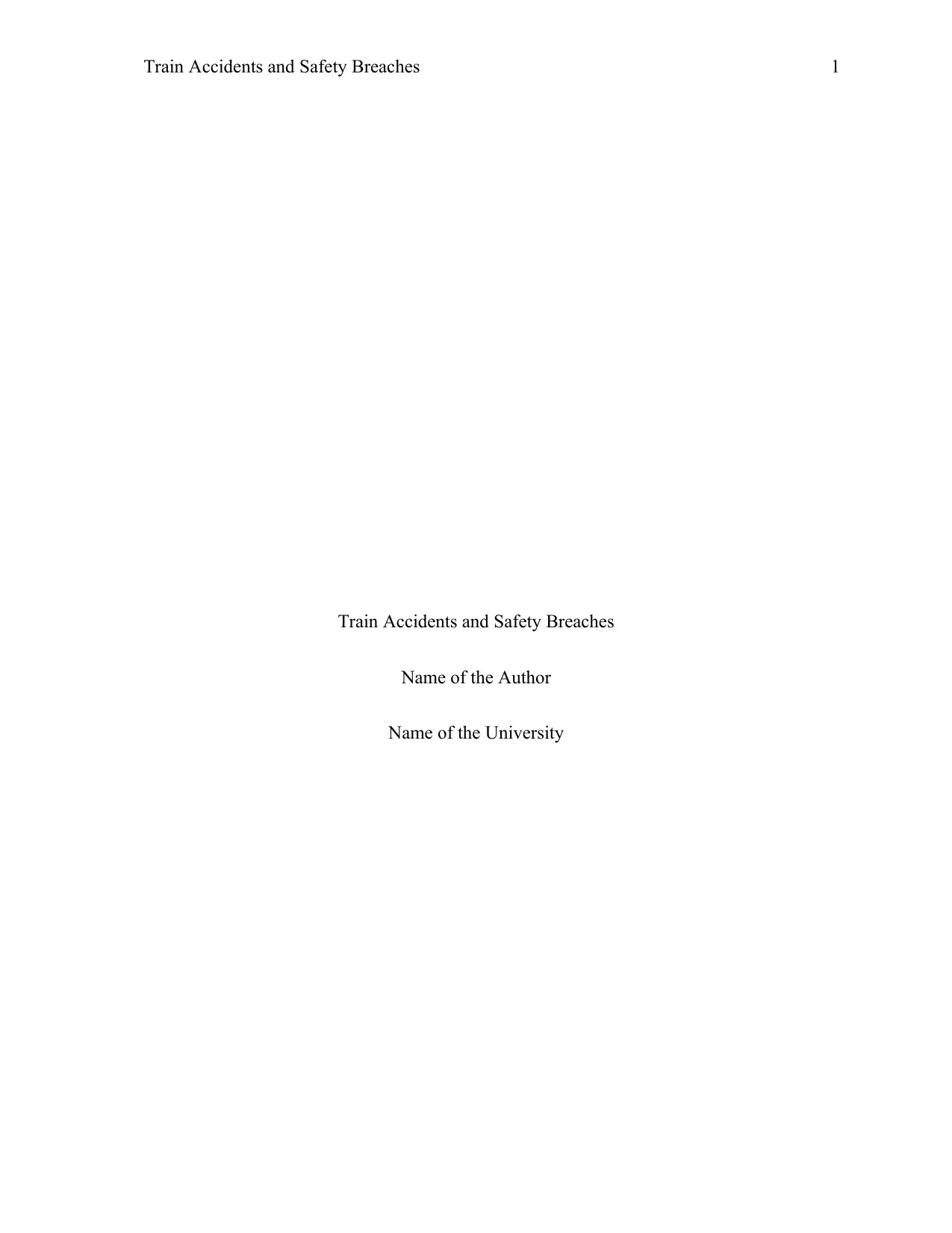
Train Accidents and Safety Breaches 1
Train Accidents and Safety Breaches
Name of the Author
Name of the University
Train Accidents and Safety Breaches
Name of the Author
Name of the University
Paraphrase This Document
Need a fresh take? Get an instant paraphrase of this document with our AI Paraphraser

Train Accidents and Safety Breaches 2
Executive Summary
There are different modes of transport which are used by people throughout the world. One of
the transports is the rail system. Like every mode of transport, the rail system has many safety
procedures. However, many staff members neglect these safety procedures, which cause train
accidents. Through this paper, one of such train accidents occurred in Santiago in 2013 is
described. The main reason for this accident was because of the overspeed of the train. This
happened because of the negligence of the driver and other staff members. These safety breaches
are mainly caused due to the human factors and it is important to make some rules for the proper
functioning of safety procedures in the railroad system. After the incident, the government has
made several corrective actions for the future so that no such incidents occur in the future.
Executive Summary
There are different modes of transport which are used by people throughout the world. One of
the transports is the rail system. Like every mode of transport, the rail system has many safety
procedures. However, many staff members neglect these safety procedures, which cause train
accidents. Through this paper, one of such train accidents occurred in Santiago in 2013 is
described. The main reason for this accident was because of the overspeed of the train. This
happened because of the negligence of the driver and other staff members. These safety breaches
are mainly caused due to the human factors and it is important to make some rules for the proper
functioning of safety procedures in the railroad system. After the incident, the government has
made several corrective actions for the future so that no such incidents occur in the future.

Train Accidents and Safety Breaches 3
Introduction
Rail transport is a great medium of transport as it connects the densely populated areas nationally
and internationally with high speed. This is the reason this mode of transport is made more
efficient and effective. Because of the requirement of rail transport, it is important to ensure the
security and safety of passengers travelling in railways. This paper describes a rail accident
which occurred in Santiago on July 2013 and the safety breaches because of which this accident
occurred. Through this paper, it has been described some measures to reduce rail accidents in
future (El-Miloudi El-Koursi and Jean-Luc Bruyelle, 2016).
Incident Description
The most widespread high-speed railway networks in the world were built and maintained by the
infrastructure company Adif which is a state-owned company. The rolling stack is managed by
another state-owned company named Renfe. A high-speed rail line, Olmedo-Zamora-Galicia in
Spain was completed only partially in which some sections of the high-speed railway were in
service while some of the sections have remained as a conventional rail line. The Renfe class 730
passenger train can run on both types of tracks. Hence, it was in service on this rail line (Saha,
2013).
The derailment incident happened on 24th July 2013. The passenger train was travelling to Ferrol
from Madrid. This train was derailed 2.5 miles before the railway station at Santiago de
Compostela when it was on high speed on a curve. During the railway accident, about 79 people
were killed and 140 people were injured. After forty years of a train crash, this was the worst
train crash in Spain. According to the data recorder of the train, the train was running at about
double speed limit which was posted for the train when it entered the curve in the railway track.
Introduction
Rail transport is a great medium of transport as it connects the densely populated areas nationally
and internationally with high speed. This is the reason this mode of transport is made more
efficient and effective. Because of the requirement of rail transport, it is important to ensure the
security and safety of passengers travelling in railways. This paper describes a rail accident
which occurred in Santiago on July 2013 and the safety breaches because of which this accident
occurred. Through this paper, it has been described some measures to reduce rail accidents in
future (El-Miloudi El-Koursi and Jean-Luc Bruyelle, 2016).
Incident Description
The most widespread high-speed railway networks in the world were built and maintained by the
infrastructure company Adif which is a state-owned company. The rolling stack is managed by
another state-owned company named Renfe. A high-speed rail line, Olmedo-Zamora-Galicia in
Spain was completed only partially in which some sections of the high-speed railway were in
service while some of the sections have remained as a conventional rail line. The Renfe class 730
passenger train can run on both types of tracks. Hence, it was in service on this rail line (Saha,
2013).
The derailment incident happened on 24th July 2013. The passenger train was travelling to Ferrol
from Madrid. This train was derailed 2.5 miles before the railway station at Santiago de
Compostela when it was on high speed on a curve. During the railway accident, about 79 people
were killed and 140 people were injured. After forty years of a train crash, this was the worst
train crash in Spain. According to the data recorder of the train, the train was running at about
double speed limit which was posted for the train when it entered the curve in the railway track.
⊘ This is a preview!⊘
Do you want full access?
Subscribe today to unlock all pages.

Trusted by 1+ million students worldwide

Train Accidents and Safety Breaches 4
Based on the recording of the crash, it was observed that all train cars were derailed and four of
them were overturned. When this accident occurred, the driver of the train named Francisco Jose
Garzon Amo was using his mobile phone just before the derailment. Due to the high speed of the
train at the sharp bend, the train left the track and derailed. As suggested by the officials, the
main causing factor of the crash was the high speed of the train. The driver faced the charges for
killing eighty people during the train crash. During the first trial, only the driver was found guilty
for the accident (Dawber, 2015). Soon after the incident occurred, the driver was detained for
this crime and accused of recklessness (AFP, 2013).
Andres Maria Cortabitarte was the safety director at the infrastructure company Adif at the time
of the rail crash incident. After a few more pieces of evidence, he was also found responsible for
the incident as he had ignored several important factors. According to the government official, he
had not taken various steps that were important to reduce the risks ("Spain ex-rail boss charged
over Santiago train crash that killed 80", 2017).
There are many safety breaches that led to this train accident. First and the most important safety
breach was over-speeding of the train by the driver. Due to the over speed of the train, the driver
loses control on the train when it entered the sharp bend. That’s why most of the cars of the train
overturned and resulted in a serious accident. The second safety breach involved in the train
crash was the involvement of the driver on the mobile phone while running a train. Since the
driver was on the mobile phone, he had no idea of coming sharp bend, which resulted in the
high-speed of the train while entering the curve. The third safety breach was the ignorance of the
safety director. The safety director had not performed all the safety tasks which must be
performed to reduce all types of risks. The fourth safety breach was the use of the incomplete
track for a high-speed train. For a high-speed train, it is also important to use the high-speed
Based on the recording of the crash, it was observed that all train cars were derailed and four of
them were overturned. When this accident occurred, the driver of the train named Francisco Jose
Garzon Amo was using his mobile phone just before the derailment. Due to the high speed of the
train at the sharp bend, the train left the track and derailed. As suggested by the officials, the
main causing factor of the crash was the high speed of the train. The driver faced the charges for
killing eighty people during the train crash. During the first trial, only the driver was found guilty
for the accident (Dawber, 2015). Soon after the incident occurred, the driver was detained for
this crime and accused of recklessness (AFP, 2013).
Andres Maria Cortabitarte was the safety director at the infrastructure company Adif at the time
of the rail crash incident. After a few more pieces of evidence, he was also found responsible for
the incident as he had ignored several important factors. According to the government official, he
had not taken various steps that were important to reduce the risks ("Spain ex-rail boss charged
over Santiago train crash that killed 80", 2017).
There are many safety breaches that led to this train accident. First and the most important safety
breach was over-speeding of the train by the driver. Due to the over speed of the train, the driver
loses control on the train when it entered the sharp bend. That’s why most of the cars of the train
overturned and resulted in a serious accident. The second safety breach involved in the train
crash was the involvement of the driver on the mobile phone while running a train. Since the
driver was on the mobile phone, he had no idea of coming sharp bend, which resulted in the
high-speed of the train while entering the curve. The third safety breach was the ignorance of the
safety director. The safety director had not performed all the safety tasks which must be
performed to reduce all types of risks. The fourth safety breach was the use of the incomplete
track for a high-speed train. For a high-speed train, it is also important to use the high-speed
Paraphrase This Document
Need a fresh take? Get an instant paraphrase of this document with our AI Paraphraser
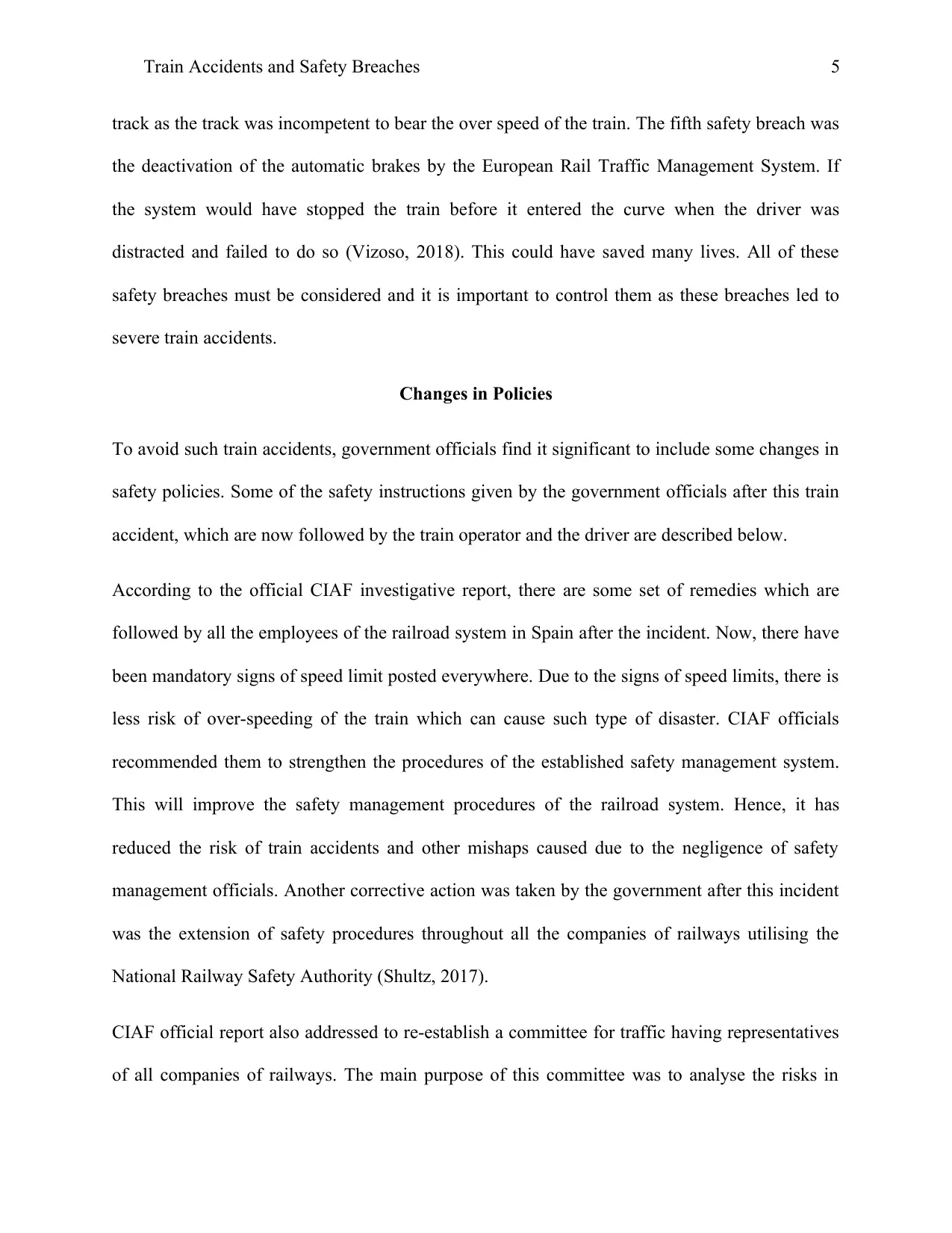
Train Accidents and Safety Breaches 5
track as the track was incompetent to bear the over speed of the train. The fifth safety breach was
the deactivation of the automatic brakes by the European Rail Traffic Management System. If
the system would have stopped the train before it entered the curve when the driver was
distracted and failed to do so (Vizoso, 2018). This could have saved many lives. All of these
safety breaches must be considered and it is important to control them as these breaches led to
severe train accidents.
Changes in Policies
To avoid such train accidents, government officials find it significant to include some changes in
safety policies. Some of the safety instructions given by the government officials after this train
accident, which are now followed by the train operator and the driver are described below.
According to the official CIAF investigative report, there are some set of remedies which are
followed by all the employees of the railroad system in Spain after the incident. Now, there have
been mandatory signs of speed limit posted everywhere. Due to the signs of speed limits, there is
less risk of over-speeding of the train which can cause such type of disaster. CIAF officials
recommended them to strengthen the procedures of the established safety management system.
This will improve the safety management procedures of the railroad system. Hence, it has
reduced the risk of train accidents and other mishaps caused due to the negligence of safety
management officials. Another corrective action was taken by the government after this incident
was the extension of safety procedures throughout all the companies of railways utilising the
National Railway Safety Authority (Shultz, 2017).
CIAF official report also addressed to re-establish a committee for traffic having representatives
of all companies of railways. The main purpose of this committee was to analyse the risks in
track as the track was incompetent to bear the over speed of the train. The fifth safety breach was
the deactivation of the automatic brakes by the European Rail Traffic Management System. If
the system would have stopped the train before it entered the curve when the driver was
distracted and failed to do so (Vizoso, 2018). This could have saved many lives. All of these
safety breaches must be considered and it is important to control them as these breaches led to
severe train accidents.
Changes in Policies
To avoid such train accidents, government officials find it significant to include some changes in
safety policies. Some of the safety instructions given by the government officials after this train
accident, which are now followed by the train operator and the driver are described below.
According to the official CIAF investigative report, there are some set of remedies which are
followed by all the employees of the railroad system in Spain after the incident. Now, there have
been mandatory signs of speed limit posted everywhere. Due to the signs of speed limits, there is
less risk of over-speeding of the train which can cause such type of disaster. CIAF officials
recommended them to strengthen the procedures of the established safety management system.
This will improve the safety management procedures of the railroad system. Hence, it has
reduced the risk of train accidents and other mishaps caused due to the negligence of safety
management officials. Another corrective action was taken by the government after this incident
was the extension of safety procedures throughout all the companies of railways utilising the
National Railway Safety Authority (Shultz, 2017).
CIAF official report also addressed to re-establish a committee for traffic having representatives
of all companies of railways. The main purpose of this committee was to analyse the risks in

Train Accidents and Safety Breaches 6
terms of vehicles, lines, and roadways. Additionally, it has recommended to have a proper
analysis of the risks in the particular route before the development of new railway lines.
According to the investigative report of CIAF, it is mandatory to develop secure systems for
communication for the train staff members. This is very helpful in reducing the risk of distraction
that leads to the train accident. Based on this report, there had been the implementation of video
recording and surveillance camera in the cabin of the driver (Puente, 2014).
After the train accident occurred in 2013 in Spain, the rail authority of Spain immediately
installed three Automatic Braking and Announcement of Signals or ASFA balises just before the
Santiago de Compostela train station. These signals were installed on 1.9 km before reaching the
train station so that the enforcement of speed limits of 30, 60, and 160 km/h can take place. The
instalment of these signals can prevent trains from approaching the same speed limit which has
caused the derailment of the train at that time ("Further safety measures follow Santiago de
Compostela crash", 2013).
According to some reports, balises which were installed after the train incident are track-
mounted programmable transponders. These transponders have the unique feature of
communicating with the on-board computers on high-speed trains in Spain. These transponders
can apply automatic brakes in the train if the restriction of speed is not followed by the driver
("Santiago de Compostela Rail Disaster (2013) |", 2015).
There were also certain protocols that had been reviewed after the incident to understand the
factors which led to the train accident at that time. The Spanish rail system has improved the
communication procedures between the driver and the staff of the control centre to avoid such
type of accidents occur in the future (Ishikawa & Tsujimoto, 2015).
terms of vehicles, lines, and roadways. Additionally, it has recommended to have a proper
analysis of the risks in the particular route before the development of new railway lines.
According to the investigative report of CIAF, it is mandatory to develop secure systems for
communication for the train staff members. This is very helpful in reducing the risk of distraction
that leads to the train accident. Based on this report, there had been the implementation of video
recording and surveillance camera in the cabin of the driver (Puente, 2014).
After the train accident occurred in 2013 in Spain, the rail authority of Spain immediately
installed three Automatic Braking and Announcement of Signals or ASFA balises just before the
Santiago de Compostela train station. These signals were installed on 1.9 km before reaching the
train station so that the enforcement of speed limits of 30, 60, and 160 km/h can take place. The
instalment of these signals can prevent trains from approaching the same speed limit which has
caused the derailment of the train at that time ("Further safety measures follow Santiago de
Compostela crash", 2013).
According to some reports, balises which were installed after the train incident are track-
mounted programmable transponders. These transponders have the unique feature of
communicating with the on-board computers on high-speed trains in Spain. These transponders
can apply automatic brakes in the train if the restriction of speed is not followed by the driver
("Santiago de Compostela Rail Disaster (2013) |", 2015).
There were also certain protocols that had been reviewed after the incident to understand the
factors which led to the train accident at that time. The Spanish rail system has improved the
communication procedures between the driver and the staff of the control centre to avoid such
type of accidents occur in the future (Ishikawa & Tsujimoto, 2015).
⊘ This is a preview!⊘
Do you want full access?
Subscribe today to unlock all pages.

Trusted by 1+ million students worldwide
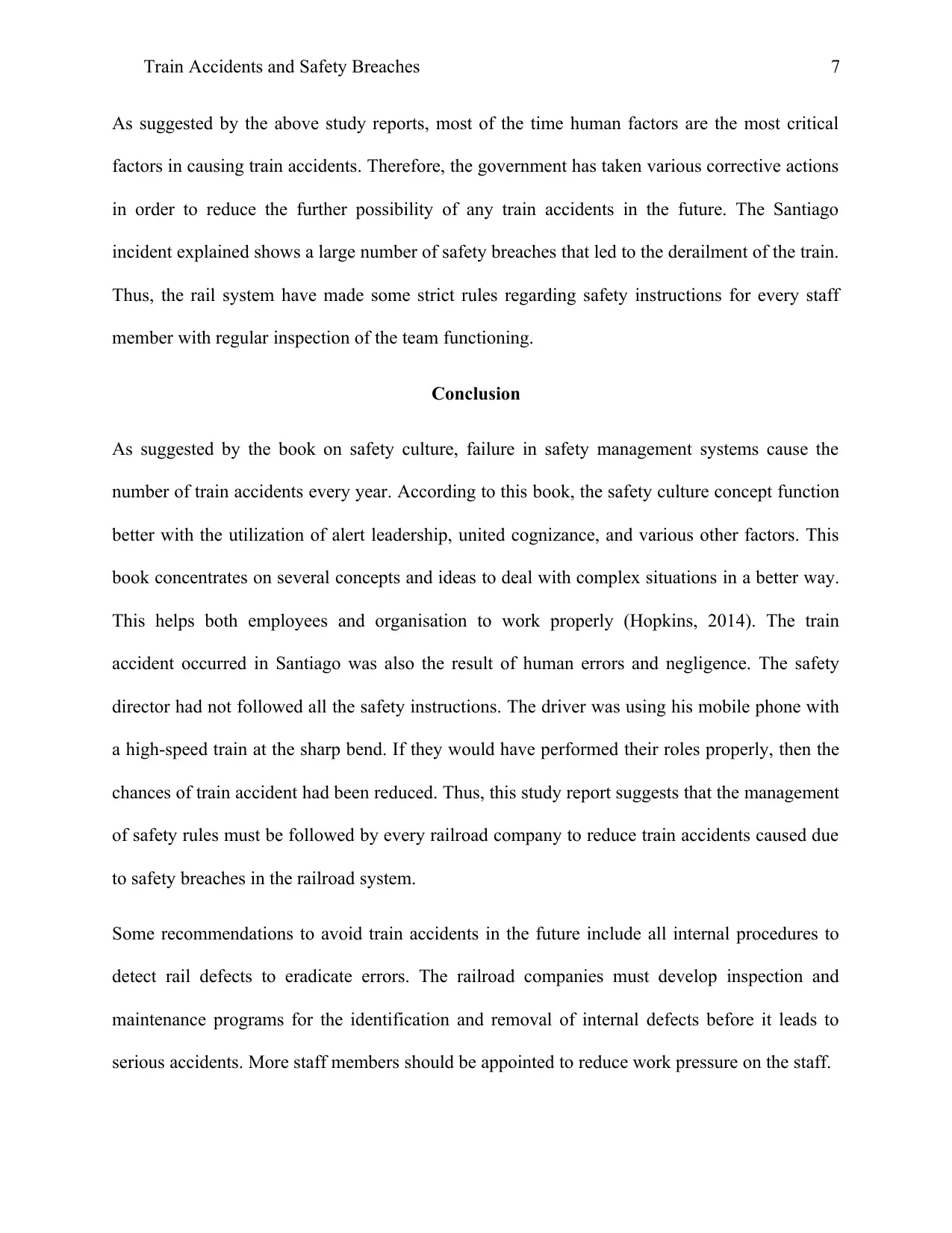
Train Accidents and Safety Breaches 7
As suggested by the above study reports, most of the time human factors are the most critical
factors in causing train accidents. Therefore, the government has taken various corrective actions
in order to reduce the further possibility of any train accidents in the future. The Santiago
incident explained shows a large number of safety breaches that led to the derailment of the train.
Thus, the rail system have made some strict rules regarding safety instructions for every staff
member with regular inspection of the team functioning.
Conclusion
As suggested by the book on safety culture, failure in safety management systems cause the
number of train accidents every year. According to this book, the safety culture concept function
better with the utilization of alert leadership, united cognizance, and various other factors. This
book concentrates on several concepts and ideas to deal with complex situations in a better way.
This helps both employees and organisation to work properly (Hopkins, 2014). The train
accident occurred in Santiago was also the result of human errors and negligence. The safety
director had not followed all the safety instructions. The driver was using his mobile phone with
a high-speed train at the sharp bend. If they would have performed their roles properly, then the
chances of train accident had been reduced. Thus, this study report suggests that the management
of safety rules must be followed by every railroad company to reduce train accidents caused due
to safety breaches in the railroad system.
Some recommendations to avoid train accidents in the future include all internal procedures to
detect rail defects to eradicate errors. The railroad companies must develop inspection and
maintenance programs for the identification and removal of internal defects before it leads to
serious accidents. More staff members should be appointed to reduce work pressure on the staff.
As suggested by the above study reports, most of the time human factors are the most critical
factors in causing train accidents. Therefore, the government has taken various corrective actions
in order to reduce the further possibility of any train accidents in the future. The Santiago
incident explained shows a large number of safety breaches that led to the derailment of the train.
Thus, the rail system have made some strict rules regarding safety instructions for every staff
member with regular inspection of the team functioning.
Conclusion
As suggested by the book on safety culture, failure in safety management systems cause the
number of train accidents every year. According to this book, the safety culture concept function
better with the utilization of alert leadership, united cognizance, and various other factors. This
book concentrates on several concepts and ideas to deal with complex situations in a better way.
This helps both employees and organisation to work properly (Hopkins, 2014). The train
accident occurred in Santiago was also the result of human errors and negligence. The safety
director had not followed all the safety instructions. The driver was using his mobile phone with
a high-speed train at the sharp bend. If they would have performed their roles properly, then the
chances of train accident had been reduced. Thus, this study report suggests that the management
of safety rules must be followed by every railroad company to reduce train accidents caused due
to safety breaches in the railroad system.
Some recommendations to avoid train accidents in the future include all internal procedures to
detect rail defects to eradicate errors. The railroad companies must develop inspection and
maintenance programs for the identification and removal of internal defects before it leads to
serious accidents. More staff members should be appointed to reduce work pressure on the staff.
Paraphrase This Document
Need a fresh take? Get an instant paraphrase of this document with our AI Paraphraser

Train Accidents and Safety Breaches 8
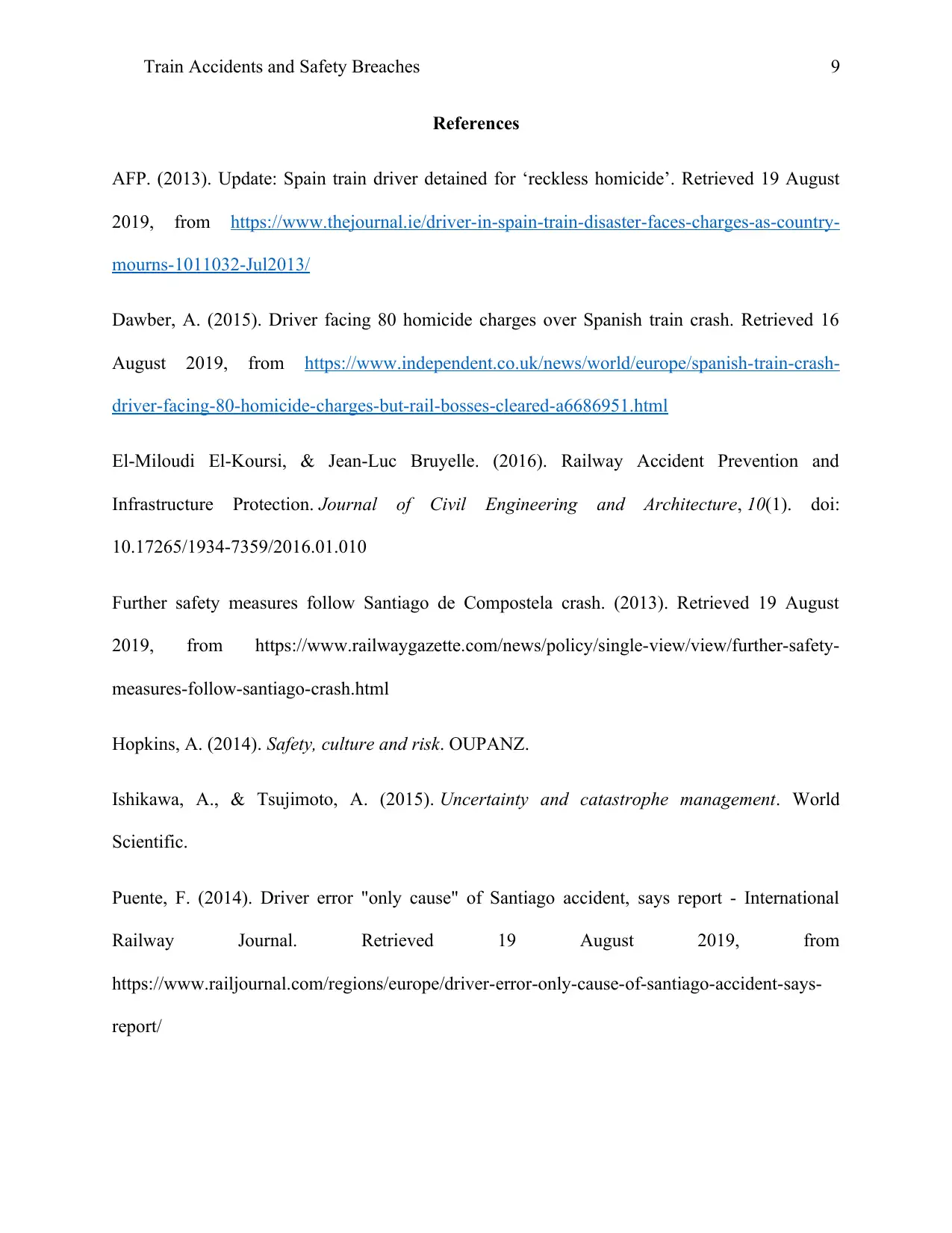
Train Accidents and Safety Breaches 9
References
AFP. (2013). Update: Spain train driver detained for ‘reckless homicide’. Retrieved 19 August
2019, from https://www.thejournal.ie/driver-in-spain-train-disaster-faces-charges-as-country-
mourns-1011032-Jul2013/
Dawber, A. (2015). Driver facing 80 homicide charges over Spanish train crash. Retrieved 16
August 2019, from https://www.independent.co.uk/news/world/europe/spanish-train-crash-
driver-facing-80-homicide-charges-but-rail-bosses-cleared-a6686951.html
El-Miloudi El-Koursi, & Jean-Luc Bruyelle. (2016). Railway Accident Prevention and
Infrastructure Protection. Journal of Civil Engineering and Architecture, 10(1). doi:
10.17265/1934-7359/2016.01.010
Further safety measures follow Santiago de Compostela crash. (2013). Retrieved 19 August
2019, from https://www.railwaygazette.com/news/policy/single-view/view/further-safety-
measures-follow-santiago-crash.html
Hopkins, A. (2014). Safety, culture and risk. OUPANZ.
Ishikawa, A., & Tsujimoto, A. (2015). Uncertainty and catastrophe management. World
Scientific.
Puente, F. (2014). Driver error "only cause" of Santiago accident, says report - International
Railway Journal. Retrieved 19 August 2019, from
https://www.railjournal.com/regions/europe/driver-error-only-cause-of-santiago-accident-says-
report/
References
AFP. (2013). Update: Spain train driver detained for ‘reckless homicide’. Retrieved 19 August
2019, from https://www.thejournal.ie/driver-in-spain-train-disaster-faces-charges-as-country-
mourns-1011032-Jul2013/
Dawber, A. (2015). Driver facing 80 homicide charges over Spanish train crash. Retrieved 16
August 2019, from https://www.independent.co.uk/news/world/europe/spanish-train-crash-
driver-facing-80-homicide-charges-but-rail-bosses-cleared-a6686951.html
El-Miloudi El-Koursi, & Jean-Luc Bruyelle. (2016). Railway Accident Prevention and
Infrastructure Protection. Journal of Civil Engineering and Architecture, 10(1). doi:
10.17265/1934-7359/2016.01.010
Further safety measures follow Santiago de Compostela crash. (2013). Retrieved 19 August
2019, from https://www.railwaygazette.com/news/policy/single-view/view/further-safety-
measures-follow-santiago-crash.html
Hopkins, A. (2014). Safety, culture and risk. OUPANZ.
Ishikawa, A., & Tsujimoto, A. (2015). Uncertainty and catastrophe management. World
Scientific.
Puente, F. (2014). Driver error "only cause" of Santiago accident, says report - International
Railway Journal. Retrieved 19 August 2019, from
https://www.railjournal.com/regions/europe/driver-error-only-cause-of-santiago-accident-says-
report/
⊘ This is a preview!⊘
Do you want full access?
Subscribe today to unlock all pages.

Trusted by 1+ million students worldwide
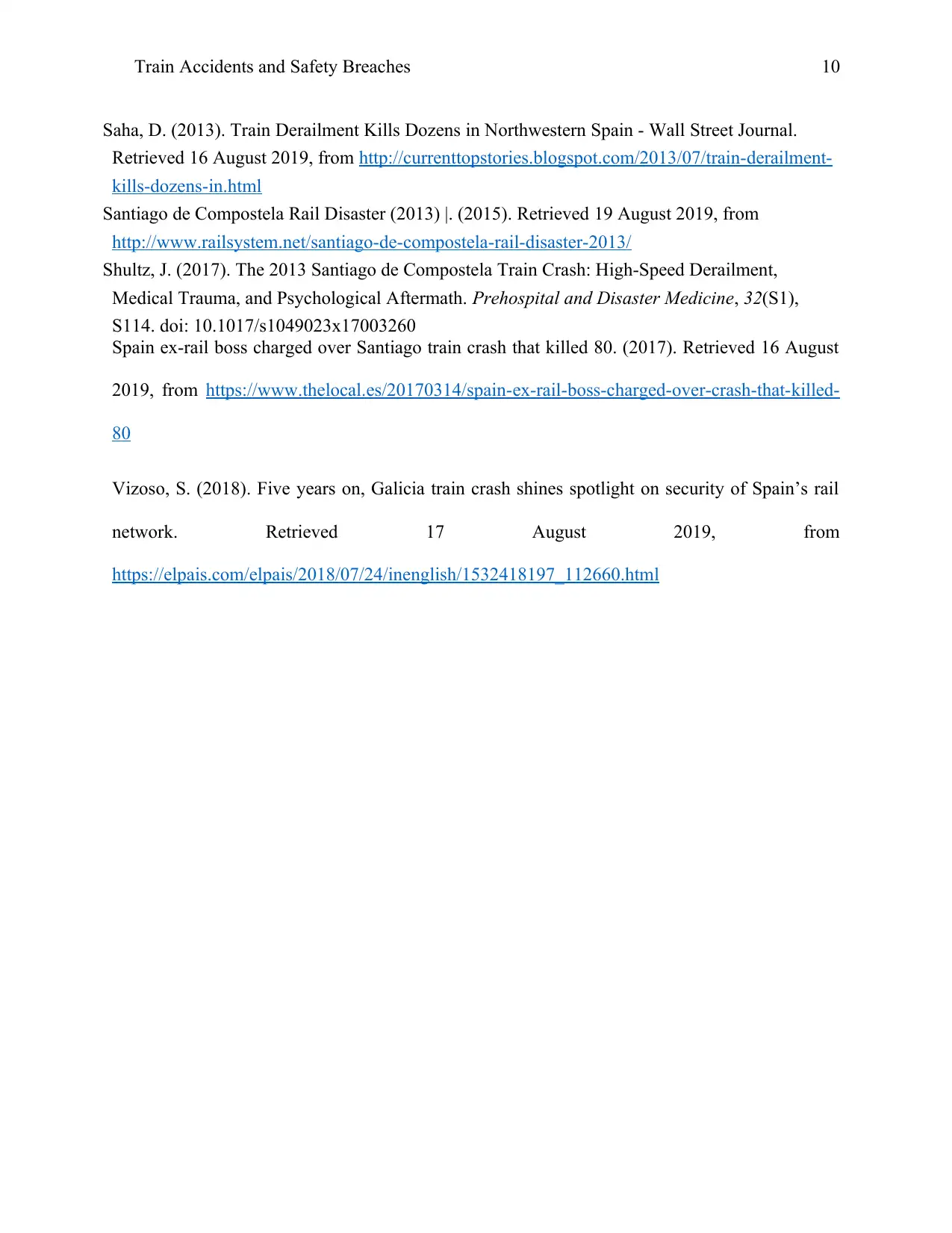
Train Accidents and Safety Breaches 10
Saha, D. (2013). Train Derailment Kills Dozens in Northwestern Spain - Wall Street Journal.
Retrieved 16 August 2019, from http://currenttopstories.blogspot.com/2013/07/train-derailment-
kills-dozens-in.html
Santiago de Compostela Rail Disaster (2013) |. (2015). Retrieved 19 August 2019, from
http://www.railsystem.net/santiago-de-compostela-rail-disaster-2013/
Shultz, J. (2017). The 2013 Santiago de Compostela Train Crash: High-Speed Derailment,
Medical Trauma, and Psychological Aftermath. Prehospital and Disaster Medicine, 32(S1),
S114. doi: 10.1017/s1049023x17003260
Spain ex-rail boss charged over Santiago train crash that killed 80. (2017). Retrieved 16 August
2019, from https://www.thelocal.es/20170314/spain-ex-rail-boss-charged-over-crash-that-killed-
80
Vizoso, S. (2018). Five years on, Galicia train crash shines spotlight on security of Spain’s rail
network. Retrieved 17 August 2019, from
https://elpais.com/elpais/2018/07/24/inenglish/1532418197_112660.html
Saha, D. (2013). Train Derailment Kills Dozens in Northwestern Spain - Wall Street Journal.
Retrieved 16 August 2019, from http://currenttopstories.blogspot.com/2013/07/train-derailment-
kills-dozens-in.html
Santiago de Compostela Rail Disaster (2013) |. (2015). Retrieved 19 August 2019, from
http://www.railsystem.net/santiago-de-compostela-rail-disaster-2013/
Shultz, J. (2017). The 2013 Santiago de Compostela Train Crash: High-Speed Derailment,
Medical Trauma, and Psychological Aftermath. Prehospital and Disaster Medicine, 32(S1),
S114. doi: 10.1017/s1049023x17003260
Spain ex-rail boss charged over Santiago train crash that killed 80. (2017). Retrieved 16 August
2019, from https://www.thelocal.es/20170314/spain-ex-rail-boss-charged-over-crash-that-killed-
80
Vizoso, S. (2018). Five years on, Galicia train crash shines spotlight on security of Spain’s rail
network. Retrieved 17 August 2019, from
https://elpais.com/elpais/2018/07/24/inenglish/1532418197_112660.html
1 out of 10
Related Documents
Your All-in-One AI-Powered Toolkit for Academic Success.
+13062052269
info@desklib.com
Available 24*7 on WhatsApp / Email
![[object Object]](/_next/static/media/star-bottom.7253800d.svg)
Unlock your academic potential
Copyright © 2020–2025 A2Z Services. All Rights Reserved. Developed and managed by ZUCOL.





